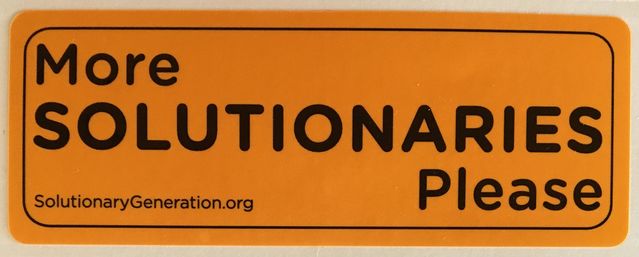
It seems appropriate to launch my new blog, Becoming a Solutionary, by defining the word solutionary and talking about why it’s so important to become one. A solutionary is someone who is able to identify inhumane and unsustainable systems, then develop solutions that are healthy and just for people, animals, and the environment.
“Solutionary” is not synonymous with “problem-solver.”
Some problem-solvers might be able to solve an engineering challenge in order to extract fossil fuels more cost-effectively, but that wouldn’t make them solutionaries.
Solutionaries are motivated by compassion and justice and driven to cultivate their creative-, critical-, strategic- and systems-thinking skills in order to address the underlying causes of entrenched and interconnected problems.
Solutionary is not just a noun; it’s also an adjective. As an adjective, it means: pertaining to or characterized by solving problems in a strategic, comprehensive manner that strives not to harm one group while helping another.
It’s not easy to devise solutionary solutions to complex challenges. If it were, we would have already solved many of our entrenched problems.
It takes research and investigation to understand the root causes, belief systems, and systemic structures that cause persistent problems. And it usually takes collaboration and divergent thinking to develop meaningful solutions.
Good deeds are not the same as solutionary solutions.
As one example, almost all communities in the U.S. include people who are experiencing homelessness. Most communities seek to help those who are homeless by providing shelters and food pantries. Community members participate in food drives and donate money to help, which is necessary humanitarian work. But these efforts are not solutionary. Next week, next month, and next year, food pantries and shelters will still need food and money if the causes of poverty have not been understood and addressed.
To be truly solutionary, a solution must significantly and strategically address the underlying causes of the problem, and it must do so without causing harm to people, animals, or the environment.
The consideration of animals in a solutionary analysis represents a departure from most problem-solving mindsets. Solutionaries consider the impact of a solution not only on the species level but also on individual animals because a just and humane world should not perpetuate cruelty toward other sentient beings.
It’s pretty obvious why it’s so important to become a solutionary.
We are facing grave and potentially catastrophic global challenges. Rainforests, glaciers, and coral reefs are disappearing rapidly. We are in the midst of a major extinction and may lose half of all species on Earth in the coming decades. Unrest and conflict, exacerbated by a growing human population and coupled with inequity and lack of access to essential resources, could increase violence and warfare.
Despite all the positive changes that have occurred in recent decades, which have resulted in (among many other things) longer average lifespans, a decline in extreme poverty, more gender equality, and universal schooling for both girls and boys appearing on the horizon, the challenges we face are profound. We need solutionaries prepared and motivated to tackle them.
The idea of becoming a solutionary sounds compelling. Who doesn’t want to make a meaningful contribution to the world? At the same time, being a solutionary requires the cultivation of a different mindset than most of us are used to.
Solutionaries try to avoid either/or thinking. They seek out nuance and want to know the impacts of an issue on all stakeholders. They eschew quick side-taking in favor of finding solutions that benefit all.
Back in the 1990s, the inclusion of the Northern Spotted Owl on the Endangered Species list turned into a typical “us v. them” scenario. The media and politicians cast the issue as a choice between owls or people, old-growth forests or logging jobs. Lawn signs sprouted in front of people’s houses expressing allegiance to one side or another.
Solutionary thinking to protect both forest habitat and people’s ability to support their families was missing.
While that particular conflict is no longer in the news, similar side-taking certainly is. People are asked to choose their team: Democrat or Republican, for the border wall or against it, supportive of universal healthcare coverage or opposed.
Solutionaries ask:
“How can we depoliticize issues such as climate change and collaborate on solutions that protect our planet as well as our economies?”
“How can we address immigration in ways that do the most good and least harm for all stakeholders, and which have the fewest unintended negative consequences?”
“How can we ensure that all people have access to the highest quality and most affordable healthcare without overburdening taxpayers?”
Such questions are hard to answer, but solutionaries strive to do so.
(Teachers can download a free Solutionary Guidebook to help their students become solutionaries, and students and changemakers can download their own free guidebook, How to Be a Solutionary: A Guide for People Who Want to Make a Positive Difference.)




